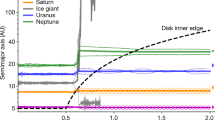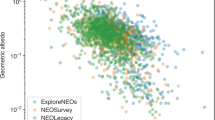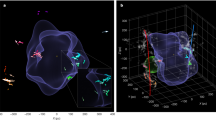Abstract
The shape of the boundary of the Solar System, defined as the surface within which the gravitational attraction of the Sun, rather than that of the rest of the Galaxy, controls the orbital motion of bodies such as planets and comets, has been determined. Outside of this surface, the dominant factors are the radial tides due to the galactic centre and, especially, the vertical tides caused by the galactic disk. Orbits which are direct with respect to the galactic plane, have a boundary which differs from that for retrograde orbits, both being 10–20% oblate and both larger than the, usually assumed, present Oort cloud. The surface may have been the boundary of the early cloud of comets which was later reduced by the passages of stars and molecular clouds.
This is a preview of subscription content, access via your institution
Access options
Subscribe to this journal
Receive 51 print issues and online access
$199.00 per year
only $3.90 per issue
Buy this article
- Purchase on Springer Link
- Instant access to full article PDF
Prices may be subject to local taxes which are calculated during checkout
Similar content being viewed by others
References
Oort, J. H. Bull. astr. Inst. Neth. 11, 91–110 (1950).
Everhart, E. Astr. J. 73, 1039–1052 (1968).
Weissman, P. R. in Comets (ed. Wilkening, L. L.) (University of Arizona Press, Tucson, 1982).
Bierman, L., Huebner, W. F. & Lust, Rh. Proc. natn. Acad. Sci. U.S.A. 80, 5151–5155 (1983).
Chebotarev, G. A. Soviet Astr. J. 8, 787–792 (1965); 10, 341–344 (1966).
deVaucouleurs, G. Astrophys. J. 268, 451–467 (1983).
Bahcall, J. N. Astrophys. J. 276, 169–181 (1984).
Antonov, V. A. & Latyshev, I. N. IAU Symp. No. 45, 341–345 (1972).
Szebehely, V. Theory of Orbits (Academic, New York, 1967).
Keenan, D. W. & Innanen, K. A. Astr. J. 80, 290–302 (1975).
Weissman, P. R. Nature 288, 242–243 (1980).
Sekanina, Z. Bull. astr. Inst. Czech. 19, 223–229 (1968).
Marsden, B. G. & Sekanina, Z. Astr. J. 78, 1118–1124 (1973).
Scalo, J. M. Fund. Cos. Phys. (in the press).
Fernández, J. A. & Jockers, K. Rep. Progr. Phys. 46, 665–772 (1983).
Napier, W. M. & Clube, V. M. Nature 282, 455–459 (1979).
Author information
Authors and Affiliations
Rights and permissions
About this article
Cite this article
Smoluchowski, R., Torbett, M. The boundary of the Solar System. Nature 311, 38–39 (1984). https://doi.org/10.1038/311038a0
Received:
Accepted:
Issue Date:
DOI: https://doi.org/10.1038/311038a0
This article is cited by
-
Dynamical Origin of Comets and Their Reservoirs
Space Science Reviews (2008)
-
How far is ‘infinity’?
General Relativity and Gravitation (2007)
-
The Oort cloud
Nature (1990)
-
The boundary to the solar system as set by a hypothetical Solar companion
Earth, Moon, and Planets (1986)
Comments
By submitting a comment you agree to abide by our Terms and Community Guidelines. If you find something abusive or that does not comply with our terms or guidelines please flag it as inappropriate.



